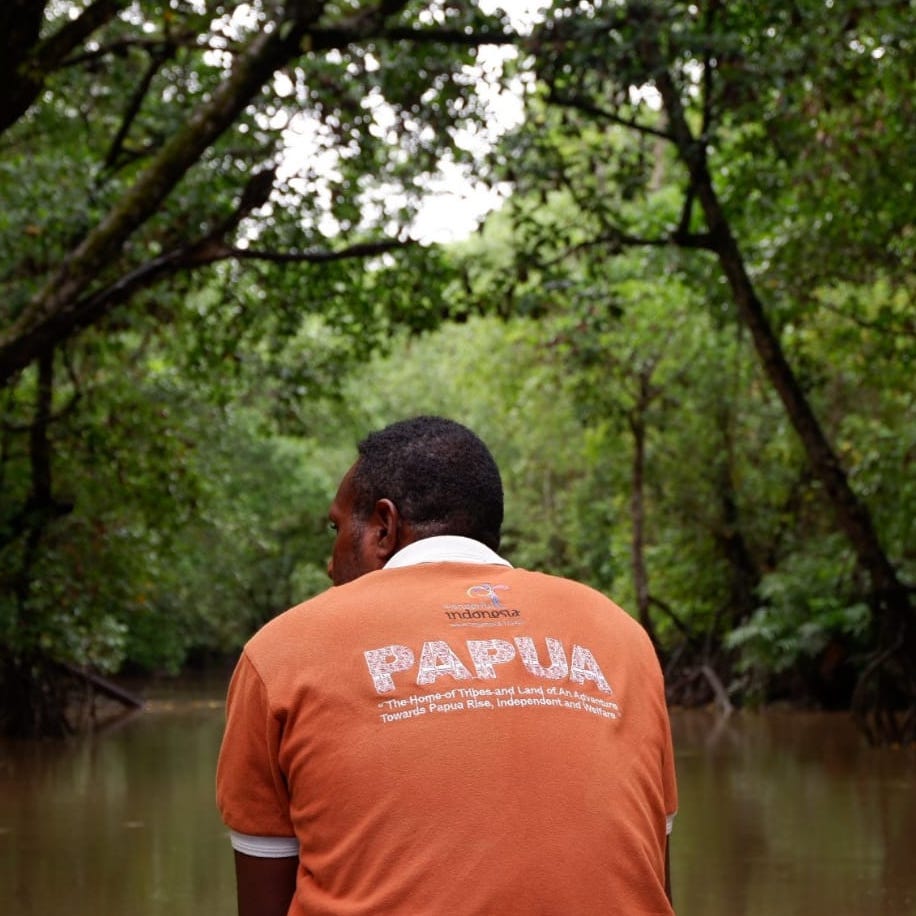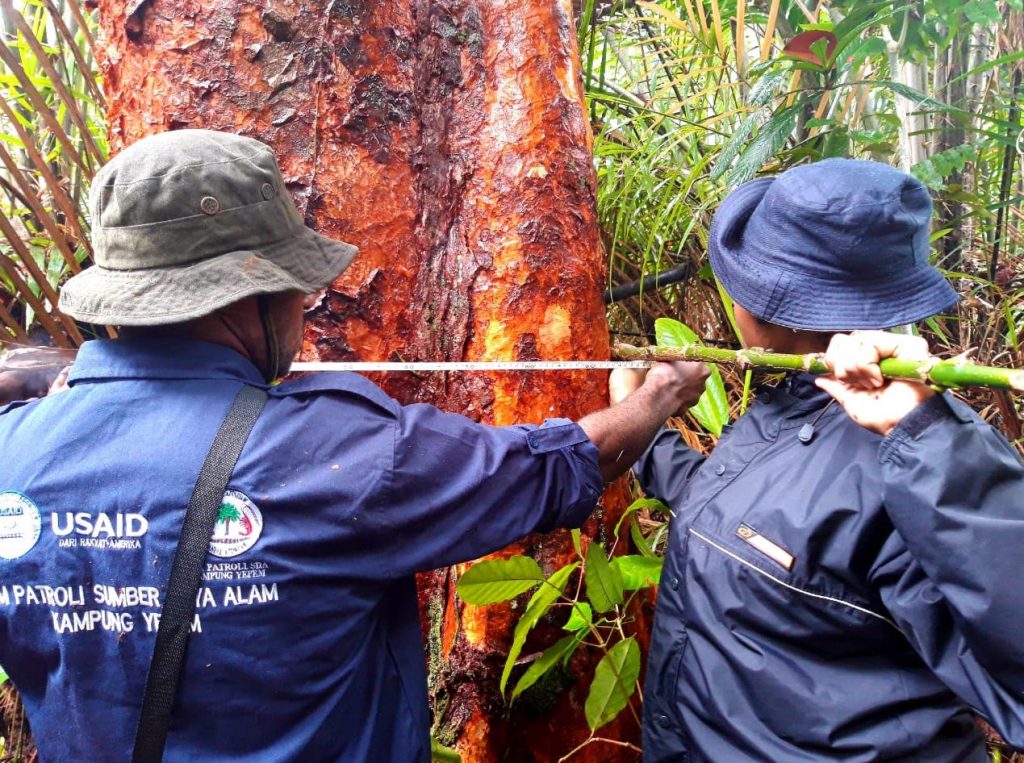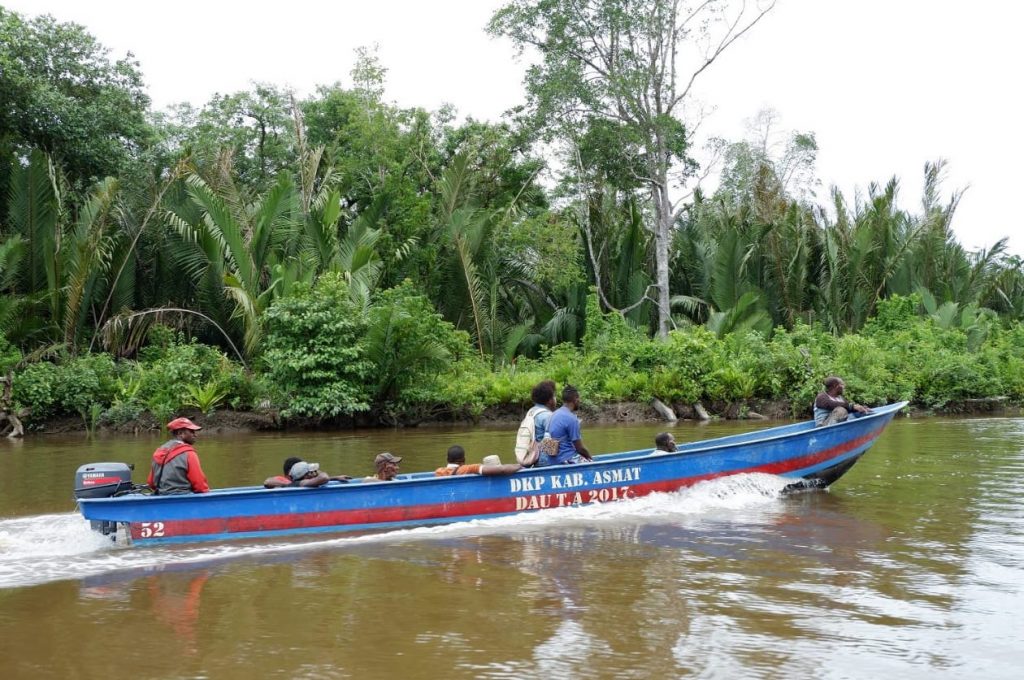The July to August period is quite a busy time for Kasimirus Yakai (29 years). In these two months Kasim, his nickname, together with his colleagues in the Natural Resources Patrol Group (SDA) of Yepem Village will participate in several activities. All these activities aim to strengthen the role of the Patrol Group and spread the spirit of conservation to various parts of the village in Asmat.
The SDA Patrol Group’s agenda in Yepem Village began with participating in a development plan (musrenbang) in Yepem Village to include operational costs for forest patrols in the 2019 fiscal year. At the end of July these local rangers will participate in the 2019 International Mangrove Day commemoration in their village. Meanwhile, during July to August they were also involved in the formation, capacity building, to accompany monitoring and patrol activities of the Forest Guard Group in several villages.
Despite undergoing a very tight schedule of activities, the faces of these young people still seemed to be always excited. “(These activities are) very important. Maintaining the preservation of customary land is not only the wayir’s (traditional elders) task. We, as the youth, must also take care to guard,” said Kasim at the moment of the International Mangrove Day 2019 celebration in Kampung Yepem (24/7).
Natural Resources Patrol Group of Yepem Village was formed by the Village Head in August 2018 through the facilitation of the USAID LESTARI program. This activity was done to respond to the need to protect natural resources, especially water sources and forest areas located in Yepem Village.
Asmat indigenous people in Yepem Village actually have a number of local wisdom in terms of protecting natural resources. For example, they are accustomed to installing prohibited signs on forest lands that are starting to become critical. This work is done to provide an opportunity for the land to grow back naturally and it is a similar moratorium in the modern conservation concept.
***
In terms of natural resource utilization the Asmat indigenous people in Yepem Village also have a hereditary habit of taking sufficiently from nature. For example, in one hole there are three mangrove crabs, so only two are taken. While one crab, especially female or still child, is left loose. “You can’t take everything. If you take it all, it will immediately run out. What will the children and grandchildren eat? ” Hilarius Jimbes, Village Chief of Yepem Village, adviced.
The traditional conservation system of the Asmat indigenous people in Yepem Village has a role in protecting nature preservation for hundreds years. However, along with the times, the role of traditional elders has been eroded. Customary institutions in villages in Asmat seem unable to compensate for the pressures of development and modernization that appeared. On this basis the Natural Resources Patrol Group was formed in Yepem Village. The team, whose members are mostly young people, has a role to balance the role of traditional institutions in guarding the issue of environmental preservation in Yepem Village.
The Yepem Village Natural Resources Patrol Group was formed on August 4, 2018, together with the establishment of the Yepem Owned Enterprise (BUM Kampung). The group currently chaired by Kasimirus Yakai is named “Buam Capinbiam Banbak Atuwcar.” It means “let’s protect the sea and forest products.” The name was chosen according to the task worked by this group, which is to preserve the natural resources of Yepem Village, especially Jomboth River water sources, forest and coastal ecosystems.
Within a few months the Natural Resources Patrol Group of Yepem Village received capacity building materials. By the USAID LESTARI program they are facilitated to develop a participatory work program. Forest monitoring tools and forms are also introduced. The Asmat District Forestry Service (CDK) branch also briefly provided training on land fire prevention. This activity was done because Yepem Village had a history of past land fires which burnt dozens of hectares of forest. While the Asmat Regency Fisheries Service also supported by appointing Patrol Group members as mangrove conservation cadres. The synergy of the parties is one of the keys to success in the process of building the capacity of the Natural Resources Patrol Group of Yepem Village.
The implementation of their work program was carried out from September 2018. Activities in the form of monitoring the forest’s condition are conducted regularly every month. It is to monitor the condition of forests and natural resources within the Asmat indigenous management area in Yepem Village. Changes in the condition of forest ecosystems as well as disturbances and threats are recorded in the forest condition monitoring sheet. The routine monitoring results are then reported to the Village Head to be followed up as needed.
“We have never found anyone who destroyed the forest on a large scale so far. What we had was that we found a garden open at the edge of a river (river border). For that, we reprimanded it. We gave an explanation that opening a garden on the edge of the river can cause erosion, said Kasimirus Yakai.
Even though they have not encountered any disturbances and threats that lead to the destruction of the forest ecosystem, the Natural Resources Patrol Group of Yepem Village remains committed to continuing to carry out forest monitoring through routine monitoring activities. The activity of the use of Kali water sources in Kali Jomboth, the main time in Yepem Village, requires attention from the community so that pollution and forest damage do not occur. The Kali Jomboth water source is currently managed by the Asmat Regency Public Works and Spatial Planning Office to support the availability of clean water in Agats City and surrounding areas. Not to mention the potential for land grabbing that can be done by neighboring villages.
We want the forests in our village to be sustainable, and keep continuing. So that these natural products can be enjoyed by the community today until later grandchildren.
Kasimirus Yakai.
So where does the funds for routine monitoring go on?
“We have never found anyone who destroyed the forest on a large scale so far. What we had was that we found a garden open at the edge of a river (river border). For that, we reprimanded it. We gave an explanation that opening a garden on the edge of the river can cause erosion, said Kasimirus Yakai.
Even though they have not encountered any disturbances and threats that lead to the destruction of the forest ecosystem, the Natural Resources Patrol Group of Yepem Village remains committed to continuing to carry out forest monitoring through routine monitoring activities. The activity of the use of Kali water sources in Kali Jomboth, the main time in Yepem Village, requires attention from the community so that pollution and forest damage do not occur. The Kali Jomboth water source is currently managed by the Asmat Regency Public Works and Spatial Planning Office to support the availability of clean water in Agats City and surrounding areas. Not to mention the potential for land grabbing that can be done by neighboring villages.
“We want the forests in our village to be sustainable, and keep continuing. So that these natural products can be enjoyed by the community today until later grandchildren,” continued Kasimirus Yakai.
So where does the funds for routine monitoring go on?
Currently the Natural Resources Patrol Group of Yepem Village can work quietly, at least until 2023. Funding for their activities has been guaranteed by the Village Head by budgeting the cost of environmental preservation in the Yepem Village Medium Term Development Plan (RPJM) document for 2018-2013. This funding source comes from the Village Fund (DD) and the Village Fund Allocation (ADD). Later the funds will be managed by the Patrol Group.
“This activity is very important. That’s why I agreed to be included in our RPJMK, “said Leonardus Jiwem, Head of Yepem Village.
***
The activities of the Natural Resources Patrol Group of Yepem Village not only contribute to preserving the environment of the village but also guarantee the availability of community livelihoods. Forest sustainability and the availability of livelihoods are two things that are interconnected in Asmat indigenous people’s lives. Livelihoods in the form of food sources, traditional medicines, as well as materials for housing and other infrastructure can only be guaranteed if forests remain in a sustainable condition. Damage to the forest ecosystem is a threat to the local livelihood availability.
Now the Natural Resources Patrol Group of Yepem Village also participates in spreading the spirit of conservation in other villages on the Asmat coast. They participated in increasing the capacity of the Forest Guard Group (KJH) in several villages formed through the USAID LESTARI program. Later all these KJHs were projected to be local rangers tasked with preserving the forests of indigenous peoples, just as what had been done by the Natural Resources Patrol Group of Yepem Village.
The experience sharing process carried out by the Patrol Group effectively provides understanding to KJH members because the material presented is good practice that has been done. Knowledge transfer is also going well because it is done by direct practice through mentoring monitoring activities of forest areas.
At each KJH capacity building session in various villages, Kasimirus Yakai and his members involved always conveyed invitations to conserve forests. They hope that the spirit of conservation that has been built in Yepem Village can spread to other villages.
We hope that people in all Asmat villages will also want to help preserve our forests. This Asmat Forest belongs to us together. If we don’t take care, who will?



